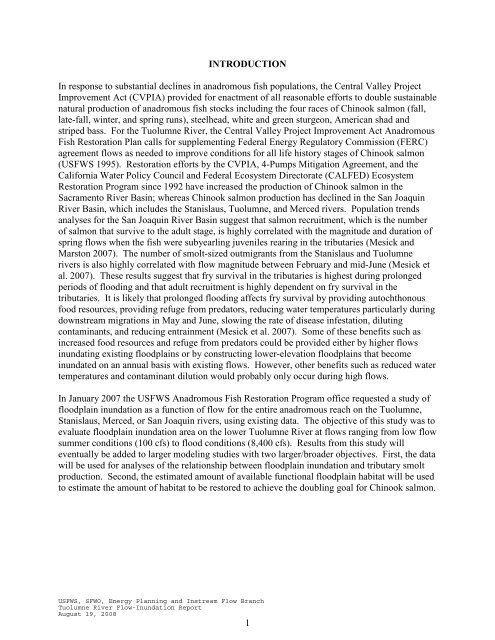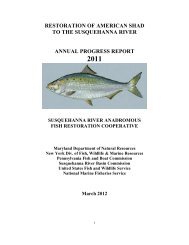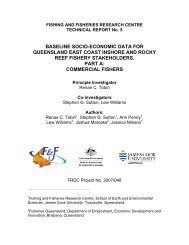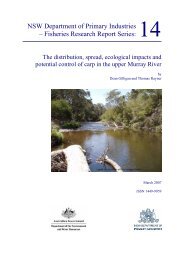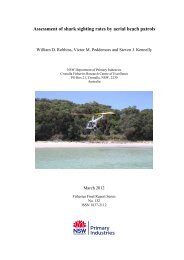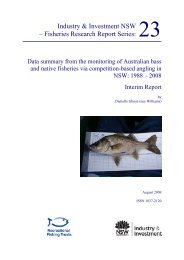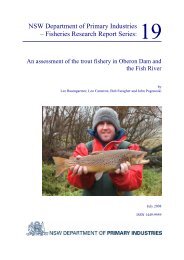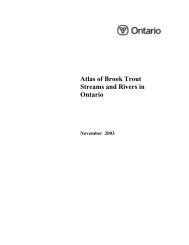Tuolumne River Flow-Inundation Report - U.S. Fish and Wildlife ...
Tuolumne River Flow-Inundation Report - U.S. Fish and Wildlife ...
Tuolumne River Flow-Inundation Report - U.S. Fish and Wildlife ...
You also want an ePaper? Increase the reach of your titles
YUMPU automatically turns print PDFs into web optimized ePapers that Google loves.
INTRODUCTION<br />
In response to substantial declines in anadromous fish populations, the Central Valley Project<br />
Improvement Act (CVPIA) provided for enactment of all reasonable efforts to double sustainable<br />
natural production of anadromous fish stocks including the four races of Chinook salmon (fall,<br />
late-fall, winter, <strong>and</strong> spring runs), steelhead, white <strong>and</strong> green sturgeon, American shad <strong>and</strong><br />
striped bass. For the <strong>Tuolumne</strong> <strong>River</strong>, the Central Valley Project Improvement Act Anadromous<br />
<strong>Fish</strong> Restoration Plan calls for supplementing Federal Energy Regulatory Commission (FERC)<br />
agreement flows as needed to improve conditions for all life history stages of Chinook salmon<br />
(USFWS 1995). Restoration efforts by the CVPIA, 4-Pumps Mitigation Agreement, <strong>and</strong> the<br />
California Water Policy Council <strong>and</strong> Federal Ecosystem Directorate (CALFED) Ecosystem<br />
Restoration Program since 1992 have increased the production of Chinook salmon in the<br />
Sacramento <strong>River</strong> Basin; whereas Chinook salmon production has declined in the San Joaquin<br />
<strong>River</strong> Basin, which includes the Stanislaus, <strong>Tuolumne</strong>, <strong>and</strong> Merced rivers. Population trends<br />
analyses for the San Joaquin <strong>River</strong> Basin suggest that salmon recruitment, which is the number<br />
of salmon that survive to the adult stage, is highly correlated with the magnitude <strong>and</strong> duration of<br />
spring flows when the fish were subyearling juveniles rearing in the tributaries (Mesick <strong>and</strong><br />
Marston 2007). The number of smolt-sized outmigrants from the Stanislaus <strong>and</strong> <strong>Tuolumne</strong><br />
rivers is also highly correlated with flow magnitude between February <strong>and</strong> mid-June (Mesick et<br />
al. 2007). These results suggest that fry survival in the tributaries is highest during prolonged<br />
periods of flooding <strong>and</strong> that adult recruitment is highly dependent on fry survival in the<br />
tributaries. It is likely that prolonged flooding affects fry survival by providing autochthonous<br />
food resources, providing refuge from predators, reducing water temperatures particularly during<br />
downstream migrations in May <strong>and</strong> June, slowing the rate of disease infestation, diluting<br />
contaminants, <strong>and</strong> reducing entrainment (Mesick et al. 2007). Some of these benefits such as<br />
increased food resources <strong>and</strong> refuge from predators could be provided either by higher flows<br />
inundating existing floodplains or by constructing lower-elevation floodplains that become<br />
inundated on an annual basis with existing flows. However, other benefits such as reduced water<br />
temperatures <strong>and</strong> contaminant dilution would probably only occur during high flows.<br />
In January 2007 the USFWS Anadromous <strong>Fish</strong> Restoration Program office requested a study of<br />
floodplain inundation as a function of flow for the entire anadromous reach on the <strong>Tuolumne</strong>,<br />
Stanislaus, Merced, or San Joaquin rivers, using existing data. The objective of this study was to<br />
evaluate floodplain inundation area on the lower <strong>Tuolumne</strong> <strong>River</strong> at flows ranging from low flow<br />
summer conditions (100 cfs) to flood conditions (8,400 cfs). Results from this study will<br />
eventually be added to larger modeling studies with two larger/broader objectives. First, the data<br />
will be used for analyses of the relationship between floodplain inundation <strong>and</strong> tributary smolt<br />
production. Second, the estimated amount of available functional floodplain habitat will be used<br />
to estimate the amount of habitat to be restored to achieve the doubling goal for Chinook salmon.<br />
USFWS, SFWO, Energy Planning <strong>and</strong> Instream <strong>Flow</strong> Branch<br />
<strong>Tuolumne</strong> <strong>River</strong> <strong>Flow</strong>-<strong>Inundation</strong> <strong>Report</strong><br />
August 19, 2008<br />
1


